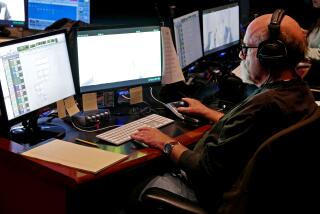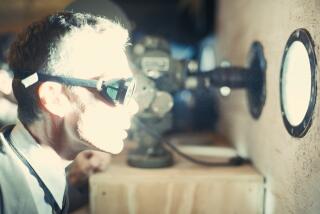Sound and Image Reunited 105 Years Later
- Share via
Around 1895, Thomas Edison’s talented assistant, William Dickson, made movie history in West Orange, N.J., when he successfully recorded sound and moving image in synchronization for the first time. Since the test was never intended for commercial distribution and never copyrighted, it has no formal title. Still, it is well-known to film historians.
In the test, Dickson, who earlier had devised the sprocket system still used in film projectors today, plays a violin while two young men solemnly dance together. The entire demonstration lasts only 17 seconds.
Now, for the first time in more than a century, sound and image have finally been reunited, thanks to the efforts of sound designer and editor Walter Murch and producer Rick Schmidlin, who previously collaborated on the reconstruction of Orson Welles’ “Touch of Evil.” George Lucas is financing the restoration, and the work in progress will premiere tonight during a tribute to Murch at the Academy of Motion Picture Arts and Sciences.
“As the first-ever document of sound and film, this has tremendous historical significance,” Schmidlin says.
The test was part of Edison’s ambitious Kinetophonograph project and took place at the inventor’s lab. Although the wax cylinder soundtrack was believed to be lost for many years, the broken cylinder was rediscovered in 1964. The cylinder was repaired and re-recorded in 1998 at the Rodgers and Hammerstein Archive of Recorded Sound in New York.
“After the Library of Congress restored the picture and had trouble syncing the sound, I was approached by Rick and Pat Loughney [head of the Library of Congress’ motion picture, broadcast and recorded sound division],” Murch recalls. “In May, I got a VHS tape of the picture and a cassette of sound. You can’t get more low-tech than that.”
Schmidlin, who has been an admirer of Edison and Dickson ever since he was a kid growing up in New Jersey, introduced Murch to Dickson’s writings during the reconstruction of “Touch of Evil.” Schmidlin explains: “‘Walter was fascinated by Dickson’s ideas on sound and film. I knew if anyone could pull this off, it was Walter.”
During the demonstration, Dickson plays a selection from “The Bells of Normandy” by Jean Planquette, an obscure light opera from 1878. Two of his assistants dance together in an attempt to sync sound with image. Although in recent years, there has been a gay connotation associated with the dancing men (thanks to the documentary “The Celluloid Closet”), Schmidlin suggests it was a technical statement, not a social one.
“Since it wasn’t meant for commercial viewing, I think the two men dancing was purely for convenience, since there weren’t any women present.”
Murch is still attempting to extract the remaining dialogue and music buried in the soundtrack just before the actual filming of the demonstration. What fascinates him is the initial piece of music Dickson plays.
“He starts off with some off-mike talking and warms up by playing a waltz, the intermezzo from Pietro Mascagni’s ‘Cavalleria Rusticana.’ This is from the famous opera featured at the beginning of ‘Raging Bull’ and the end of ‘The Godfather III.’
“Imagine, the first fragment of sound almost recorded on film came from an opera that had such an impact on these very important films.”
More to Read
Only good movies
Get the Indie Focus newsletter, Mark Olsen's weekly guide to the world of cinema.
You may occasionally receive promotional content from the Los Angeles Times.







